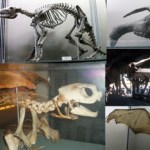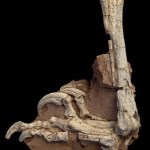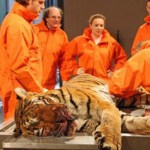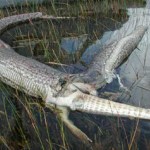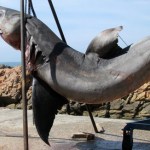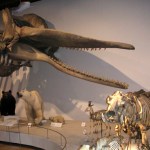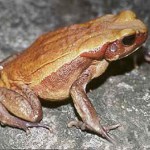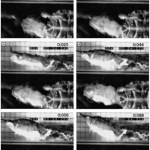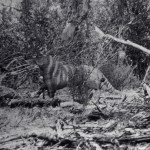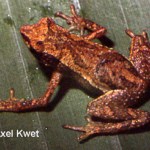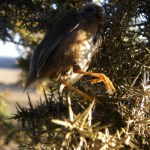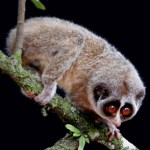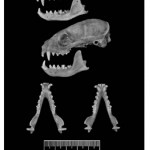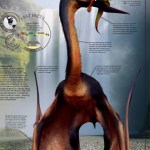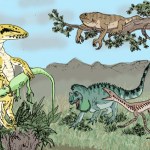
I said I wouldn't do any conferences this year. But I lied, and have recently returned from the 58th Symposium on Vertebrate Palaeontology and Comparative Anatomy (SVPCA), this year held once again in Cambridge, UK. Compared to the enormous, sprawling SVP (= Society of Vertebrate Paleontology) meeting with its numerous concurrent sessions (last year held in England, but usually held in North America), SVPCA is tiny and tidy. So, ok, there's less content, but at least you get to talk to everyone you want to, and to go to all the talks. As usual, I had an excellent time and extend warm thanks…
Regular readers will know that I like covering obscure animals... with luck, really obscure animals. The problem with such animals is that nice images hardly ever - sometimes never - exist. When they do exist, they're protected by copyright and are unavailable for use on a blog. I'm therefore eternally grateful when people are able (and kind enough) to send me photos of an obscure animal, and are able to give me permission to use them. Recently, herpetologist Kate Jackson of Whitman College, Washington, was kind enough to provide the photos you see here. Oh. My. God.
It's Bothrolycus ater…
The last few weeks have been pretty exciting for people interested in theropod dinosaurs.... but then, you could say this about most weeks: new theropods are constantly being published.
Last week saw the publication of the weird, functionally two-fingered, short-footed maniraptoran Balaur bondoc from the latest Cretaceous of the HaÅ£eg Basin in Romania (Csiki et al. 2010) [left foot of Balaur shown here, from BBC News]. When Balaur was alive, the Hateg region was an island, so this was another of those weird, island-dwelling dinosaurs we've often hoped would exist. I have a vested personal…
I hope everyone has been enjoying my write-ups of Inside Nature's Giants (ING), series 2 (for comments on episode 1 go here, and for thoughts on episode 2 go here). Time to look at ep 3: the big cat one.
Given that big cats are more popular (among the general populace) than are either sharks or snakes, it's predictable that this was the most discussed, most anticipated episode. Like the others, it was excellent [adjacent image © Windfall Films/Channel 4].
And let me say again how good the whole of ING series 2 was: well done to everyone involved, you left us wanting more. And to those who…
Episode 2 of series 2 of Inside Nature's Giants was devoted to pythons (for an article reviewing ep 1, go here). Specifically, to Burmese pythons Python molurus. And, quite right too. Snakes are among the weirdest and most phenomenally modified of tetrapods: in contrast to we boring tetrapodal tetrapods with our big limb girdles, long limbs and less than 100 vertebrae, we're talking about tubular reptiles with a few hundred vertebrae, stretched organs, distensible jaws and a total or virtual absence of limbs and limb girdles [montage above shows Simon Watt with captive Burmese python (©…
Earlier this year (in June), Channel 4 television here in the UK broadcast series 2 of Inside Nature's Giants (ING from hereon... titled Raw Anatomy in the US, you poor, poor people). You may have heard it here first. Hopefully you're familiar with ING series 1 - it looked at the anatomy of elephants, baleen whales, crocodiles and giraffes - and, if you're not, be sure to check out the Tet Zoo articles starting here. My praise for series 1 was extreme, by which I mean that I thought it was excellent: a real triumph and a major event in both the world of broadcasting, and in bringing good…
There's no denying that Physeter macrocephalus - the Sperm whale or Great sperm whale - is a very special, very weird mammal, and (as yet) I haven't done it justice at Tet Zoo. That will be rectified in time, honest (I've been keen for years to write about the suction-feeding, and about the battering ram hypothesis). The excellent Zoological Museum at Copenhagen (Denmark) has tons of amazing specimens on display, and among them is this excellent mount of a Sperm whale and an assortment of other large mammals (photos courtesy of Markus Bühler).
But... something's not right...
Yes, this…
Once more, we return to those wonderful, phenomenally successful, charismatic beasts.... the toads. As you'll know if you've read the previous articles in the toads series, it seems that most basal divergences within crown-Bufonidae happened in South America. So far as we can tell right now, crown-toads are ancestrally South American, and all of their early history happened on this continent [Rhaebo blombergi image below from here].
All of the basal toads looked at so far - the relatively small, slender-limbed, shallow-snouted members of the clades Melanophrynicus, Atelopus, Osornophryne,…
While on holiday in Wales recently, we visited Cardiff Castle. Located within the grounds is the Victorian House, extensively transformed between the late 1860s and 1930s by William Burgess under John Crichton-Stuart, 3rd Marquess of Bute. I was quite surprised to find carved platypuses, armadillos, wombats and pangolins on some of the bookcases.
Apparently they commemorate particular countries of the then Commonwealth: any idea which countries armadillos and pangolins might be associated with? There were bears and otters, too. Sorry the photos aren't great. I couldn't use the flash, and…
In the previous Matamata article I discussed the very scary skull and hyoid anatomy of this singular South American turtle. The 'ugly' look of the Matamata is well known, but hopefully you now know that the Matamata should also be famous for its large size, for its massively thick, long neck, for its pivotal historical role in our understanding of pleurodire turtle diversity, and for its freakish, flat-faced skull [illustrations above from Patrick Lemell's website].
As you'll no doubt already know, the remarkable morphology of the Matamata's head and neck correlates with a remarkable…
Photos purported to show 'mystery animals' are always great fun. One of the most perplexing and curious of the lot was taken on a box Brownie camera near Goroke, western Victoria, Australia, in 1964. I'm referring, of course, to Rilla Martin's photo of a strange, striped, running mammal.
This photo has generally become known as 'the Ozenkadnook tiger photo'; in fact, the term 'Ozenkadnook tiger' was and is used for a supposed mystery beast (suspected by witnesses and locals to be a mainland Thylacine Thylacinus cynocephalus) seen since the 1880s across southwestern Victoria and southeastern…
I'm away right now, and haven't had time to prepare new stuff. So, here's something from the archives again: by which I mean, something written in 2006. It's still pretty interesting (in my humble opinion), but I would definitely do some things differently were I to re-write it today [gliding sifaka below from Demes et al. (1991): read on].
Mention 'flying primate' and most zoologists will think you're referring to the well known, controversial theory of John Pettigrew of the University of Queensland. And if that sentence sounds familiar, it's because I used it previously to introduce a…
Lest we forget, one of my aims for 2009-2010 is TO GET THROUGH ALL THE TOADS OF THE WORLD. I don't mean every single species (because there... like, over 540 of them), but all the 'genera' at least. If you need any of the background to this grand/crazy scheme, be sure to check out the links below [image below shows Mt Kukenan in the Guyanan Highlands, and a Pebble toad Oreophrynella niger rolling downhill. Read on...].
One of the main points I've emphasised in some of the previous articles is that toads - or, crown-toads, anyway - seem to be ancestrally South American: the redbelly toads (…
A challenge for you (albeit another easy one): what species, and what activity, do these photos represent? I'll give you a few clues...
On second thoughts, I won't. Well, all I'll say is that the photos were taken in the New Forest in southern England and show one of the region's most famous birds. Tell me more!
Photos by Tara Dempsey, used with permission.
UPDATE (added 9th August 2010): Many thanks to all of you for your guesses. Many of you got it right, or mostly right. What we're looking at here is a juvenile Dartford warbler Sylvia undata, shown impaled on gorse spines. Admittedly,…
After I'd finished writing about the new Madagascan mongoose, I thought it only right to add material to the end of the article about some of the other new discoveries made in the world of mammalogy. But, as happens on so many occasions, this made the article over-long and in the end I decided to axe that additional stuff. Plus, it makes more sense to get two, three, four or more articles out of one - another familiar theme on Tet Zoo (errr, gekkotans, anurans, babirusas, matamatas, pronghorns, bird hands.... need I go on?). Anyway...
From Sri Lanka comes the news that the Horton Plains…
The fact that new, modern-day mammal species are discovered on a fairly regular basis should most definitely not be a surprise to the average Tet Zoo reader. These are not all 'cryptic species' distinguishable only on the basis of DNA: many are morphologically distinctive, honest-to-goodness new animals discovered either in the field or in museum collections. And they're not all bats and rodents: new monkeys, lemurs, sloths and hoofed mammals (peccaries, deer and bovids) have been named in recent years.
Mention 'new mammals' and 'Madagascar', and most people will assume that you're talking…
Welcome to another article on the Matamata Chelus fimbriatus. Yay!
In the previous episode we looked briefly at the Matamata's long, thick neck and on a few aspects of Matamata evolution (a brief introduction to what the Matamata is, and where it lives, can be found here) [in the composite image shown above, the skull and neck is from digimorph while the photo of the live animal is from wikipedia]. This time, we're going to look at the anatomy of the skull and hyoid skeleton (do stick with me here, it's well worth it). I made the point previously that, despite being comparatively well-…
Another book with my name on it has just appeared. Again it's a kid's book: Dorling Kindersley's Know It All (Baines 2010) - a fantastically well illustrated, fact-packed encylopedia of everything science (and the successor to the highly successful 2009 Ask Me Anything). It's a multi-authored book (authors: Simone Bos, Julie Ferris, Ian Graham, Susan Kennedy, Darren Naish, Jim Pipe, Carole Stott and John Woodward). My section - titled 'Dinosaurs' - isn't just on dinosaurs; it also includes spreads on Palaeozoic tetrapods, ichthyosaurs, pterosaurs, Pleistocene mammals, and hominids. Does it…
Some weeks ago I wrote a bit about the Matamata Chelus fimbriatus: a weird, flat-headed South American pleurodiran turtle. It's one of the strangest creatures tetrapods on the planet, and there's so much to say about it that the previous article ended up being nothing more than the briefest of introductions. Today we start looking at the Matamata in a bit more depth. We start with its affinities and its long neck...
Chelus is a chelid: that is, a member of the pleurodire turtle clade Chelidae. Despite - or perhaps because of - its bizarre appearance, the Matamata is sometimes regarded as…
